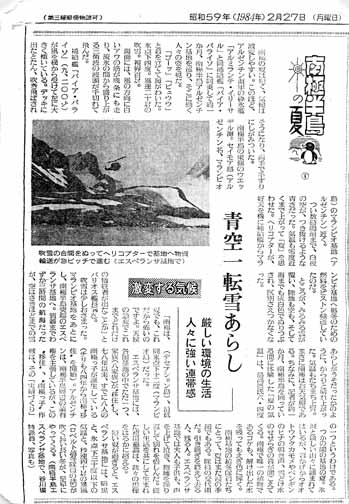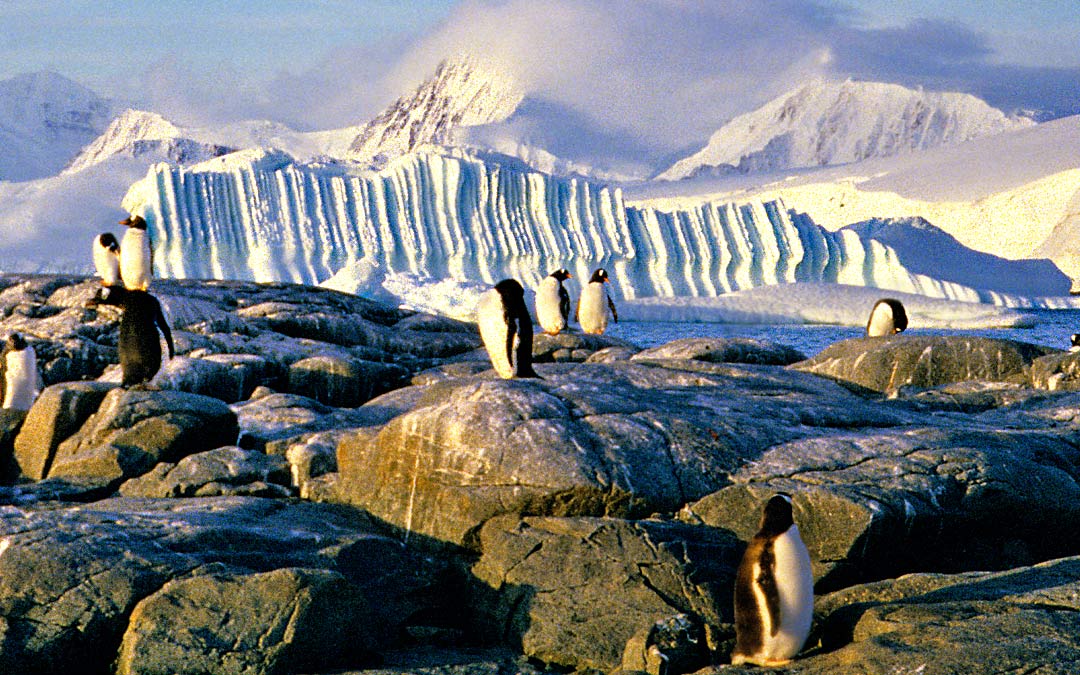
This episode can be read here.
Initially, I believed it was impossible for a small sailboat like Aomi to sail to Antarctica. Antarctica is a distant, cold place with the great danger of striking icebergs.
I could imagine Trans-Pacific or Round-the-World navigation in a small boat, but sailing to Antarctica was beyond my imagination.
Why did I plan to sail to such a place?
The motivation might have come from my successful sailing in the Patagonian Archipelago with Aomi. Patagonia and Antarctica were once part of the same ancient continent, Gondwana.
It is quite natural that the Antarctic Peninsula and Patagonia are very similar in their geographical features because they were once connected. The techniques I gained while sailing in Patagonia could be applied to navigation in the Antarctic as well.
Let's check the location on the map.
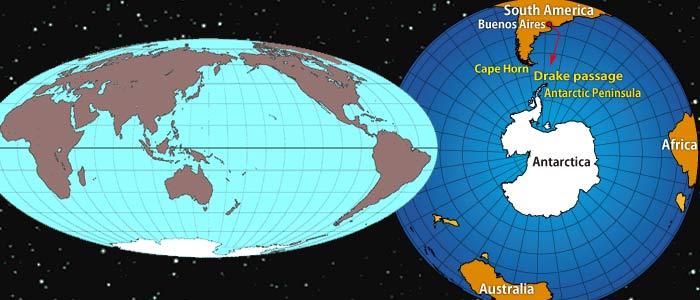
Antarctica looks like the bottom of the world, and its shape and size are unclear on the left map. The right map shows a view from the south.
Do you know how big Antarctica is? It's twice the size of Australia. The closest continent is South America, with a peninsula extending from Antarctica towards it, as shown in the image above.
The distance from South America to the Antarctic Peninsula is about 1,000 km. This is only one-tenth of the Trans-Pacific journey that Aomi made before. There was no reason not to go to Antarctica. (Note: These are the shortest distances, and the actual sailing distance will be longer.)
However, the Drake Passage between South America and Antarctica is one of the stormiest waters, often called "the worst sea on Earth." It's an exceptionally challenging sea to sail.
As shown on the map above, the Drake Passage extends even further south from Cape Horn, known as "the cemetery of ships" or "the Cape of Horror." Could I sail such a dangerous sea in a small boat like Aomi?
Even if Aomi could reach Antarctica, she would be surrounded and trapped in ice. The sharp edges of the ice might damage the F.R.P. hull. There were so many problems I couldn't fix, and I didn't know what to do.
However, I wished to reach Antarctica anyway. I desired to go there at any cost. Antarctica was just 3,500 km from Buenos Aires, the capital of Argentina, where Aomi was staying. How could I suppress my passion for Antarctica?
If I miss this opportunity, I may never have another chance in my life.
Anyway, I'll try, I decided, and started to collect information.
*
One day, when I visited the Japanese embassy in Buenos Aires, an employee gave me newspaper clippings.
One of the clippings described the weather in the Antarctic. Here is a quote from it:
Just a few hours earlier, the sky during the white night was deep blue. It had felt like summer, with the temperature rising to the freezing point.
Suddenly, clouds covered the sky, and everything turned gray. We could see no boundaries between the sky, land, and sea.
"Due to the sudden change in the weather, it is hazardous even in summer. We have many casualties," said Captain Barrios.
When the snowstorm weakened, we left Base Marambio for a few-hour trip to Base Esperanza. In the meantime, the sky cleared as if the snowstorm had been unreal.
(Written by Syuun Tanigawa)
Additionally, there was an unexpected report in the clippings.
"Before we came to the Antarctic, we met a Japanese yachtsman named Yoshi Kataoka and his sailboat Aomi. He is now sailing in Chile and Argentina and plans to navigate to the Antarctic at the end of this year. It is very risky for a single-handed sailboat because of the difficulty in spotting icebergs," said Mr. Argoud anxiously.
*
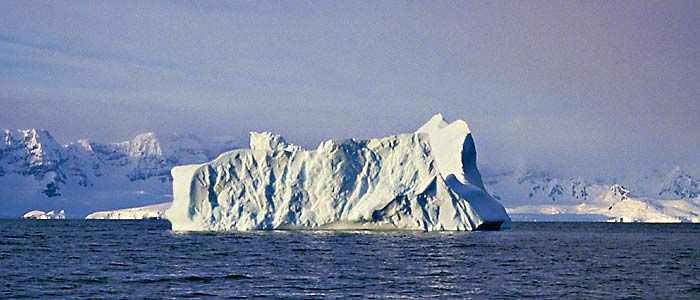
Can you guess the height of the iceberg in the photo above? The visible part is only above the water. The entire iceberg must be very large because 90% of it is underwater. If Aomi hits it, she would sink immediately.
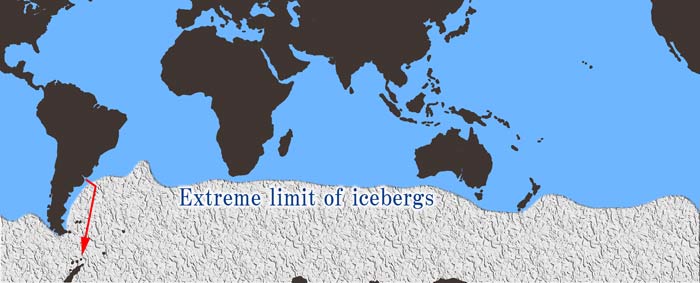
The above chart shows the areas where icebergs have been seen. The red line indicates Aomi's path. You must pass through the dangerous waters shown in white-gray to reach the Antarctic Peninsula. (Although icebergs have been observed, this does not necessarily mean that they are always present.)
The likelihood of encountering icebergs will undoubtedly increase as Aomi approaches Antarctica, especially at night.

To avoid accidents, I made a window in the sliding hatch and installed a large truck mirror to watch for ice from the quarter berth (bed). I also provided spare mirrors and safety joints in case of wave attacks.
The photo above shows the view from the bed through the mirror. The black objects in the mirror are the mast and the boom. You can also see the horizon.
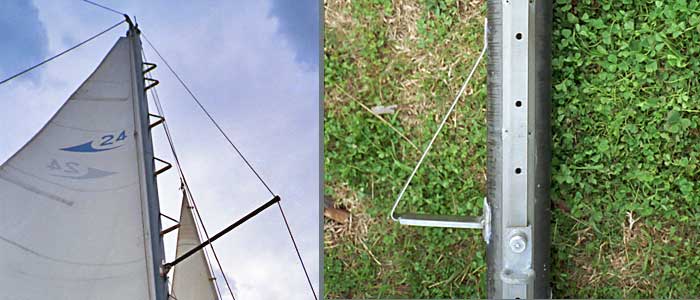
The next measure was to attach steps to the mast, allowing me to climb to the top quickly. This would help me spot icebergs from a high position or find an exit path when surrounded by ice.
I made them by bending a 25mm wide stainless steel plate and reinforcing the part where my foot would rest. I made them myself while visiting a friend's ironworks, but this ended up being one of the causes of the mast breaking during a capsize.
This happened because I attached the steps to the mast by drilling dozens of 3mm-diameter holes, which caused stress concentration and reduced the mast's strength by about a third.
Most commercially available mast steps have the same problem, so you need to be careful.
After the mast breakage during the capsize, I designed and installed a new type of mast steps, ensuring they wouldn't weaken the mast's strength.
Another problem in the Antarctic may be the erosion of the hull caused by small ice floes.
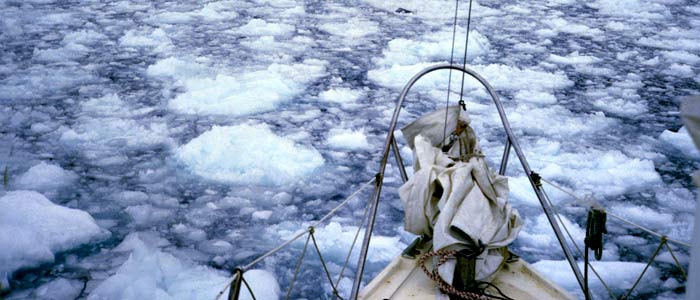
If Aomi's hull were made of steel, there would be no worries, but it is made of fiber-reinforced plastic (F.R.P.). Ice can damage this material.
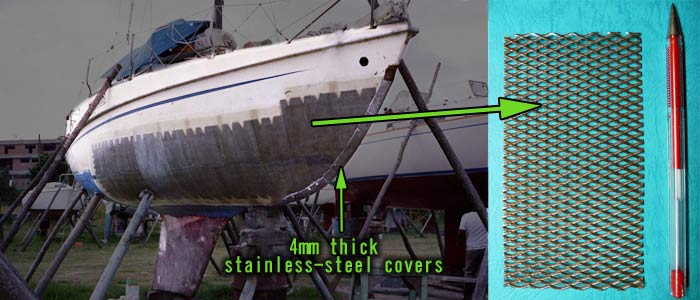
After much consideration, I covered the hull with stainless steel mesh made from 0.8mm plates. The floating ice that scratches Aomi's hull would turn into something like shaved ice![]() . To make the surface smooth, the mesh was coated with fiberglass, resin, and gel-coat paint.
. To make the surface smooth, the mesh was coated with fiberglass, resin, and gel-coat paint.
I also added V-shaped covers made of 4mm thick stainless-steel plates to the stem (bow) to protect against collisions with ice. Additionally, I built watertight compartments and a structure called an "ice beam" to reinforce the bow.
Despite making many preparations against ice and cold, I wasn't sure if they would be effective because no small boat like Aomi had ever sailed to Antarctica before.
Now, I have done all the preparation I can. The result is unknown, but I will realize my dream anyway, I muttered to myself.
The background of this page is a photo of snow taken in the Antarctic.
